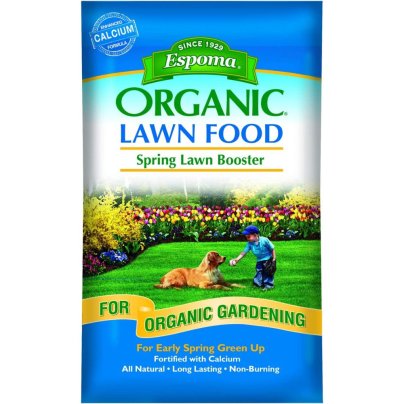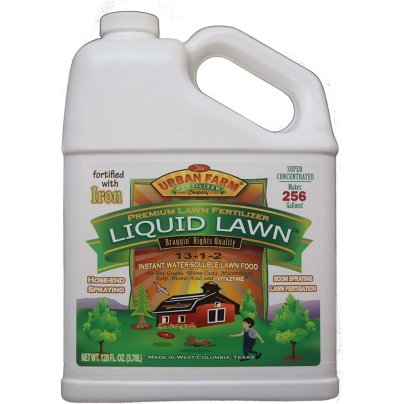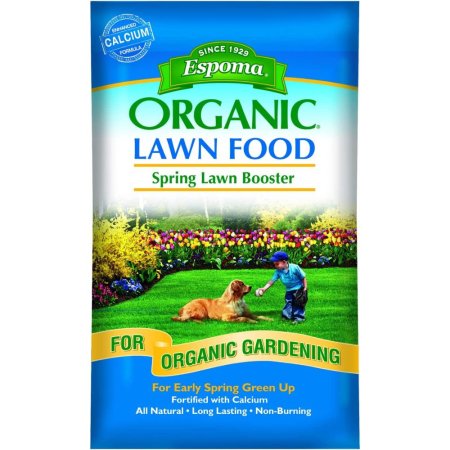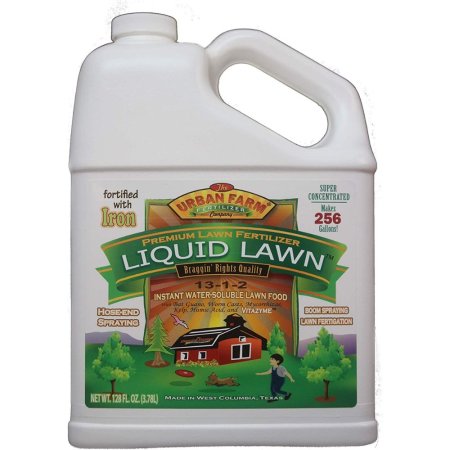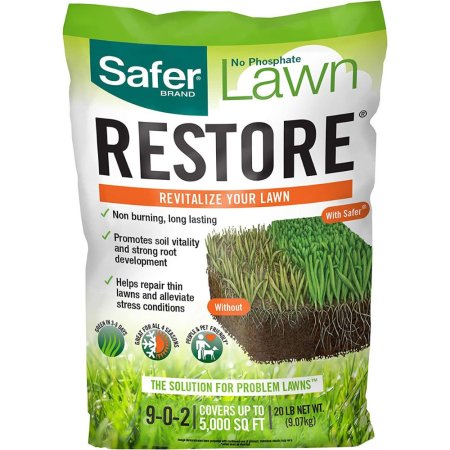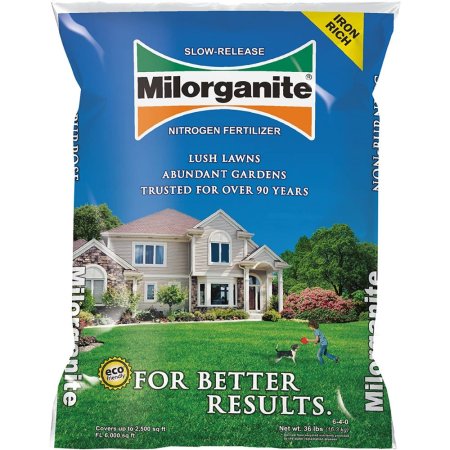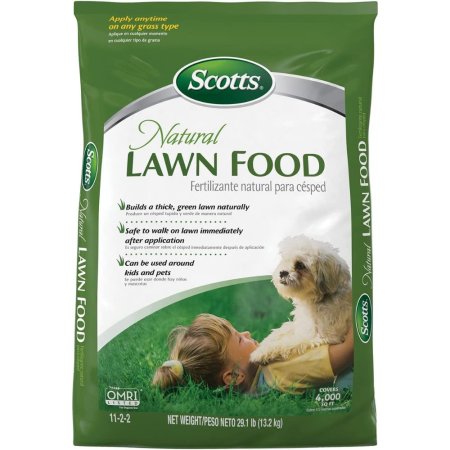
We may earn revenue from the products available on this page and participate in affiliate programs. Learn More ›
All lawns require nutrients to grow and thrive, but often there isn’t enough occurring naturally in the soil. The best lawn fertilizer for spring replenishes these nutrients and optimizes conditions for the main growing season. Generally, lawns should be fertilized at least twice yearly. Yet while the best time to fertilize lawns depends on the grass type and soil condition, almost all lawns can benefit from fertilizing at some point in the spring.
Not any random fertilizer will do the trick, however, and in fact there are many factors to consider when choosing a yard fertilizer. Lawn condition, environmental concerns, and fertilizer composition are all important considerations that will be explored ahead. Use this guide to read up on today’s top products plus essential shopping info so that you can nurture and maintain a lush, green yard.
- BEST OVERALL: Espoma Organic Lawn Food Spring Lawn Booster
- BEST BANG FOR THE BUCK: Urban Farm Fertilizer Liquid Lawn Fertilizer
- BEST LIQUID: GS Plant Foods Organic Liquid Fish
- BEST WEED AND FEED: Espoma Organic Weed Preventer
- BEST PLANT-BASED: The Andersons 7-1-2 Innova Organic Fertilizer
- BEST WITHOUT PHOSPHORUS: Safer Brand 9335SR Lawn Restore Lawn Fertilizer
- BEST FOR GREENING: Milorganite 0636 Organic Nitrogen Fertilizer
- BEST FOR LAWN AND GARDEN: AgroThrive Organic General Purpose Liquid Fertilizer
- ALSO CONSIDER: Scotts Natural Lawn Food
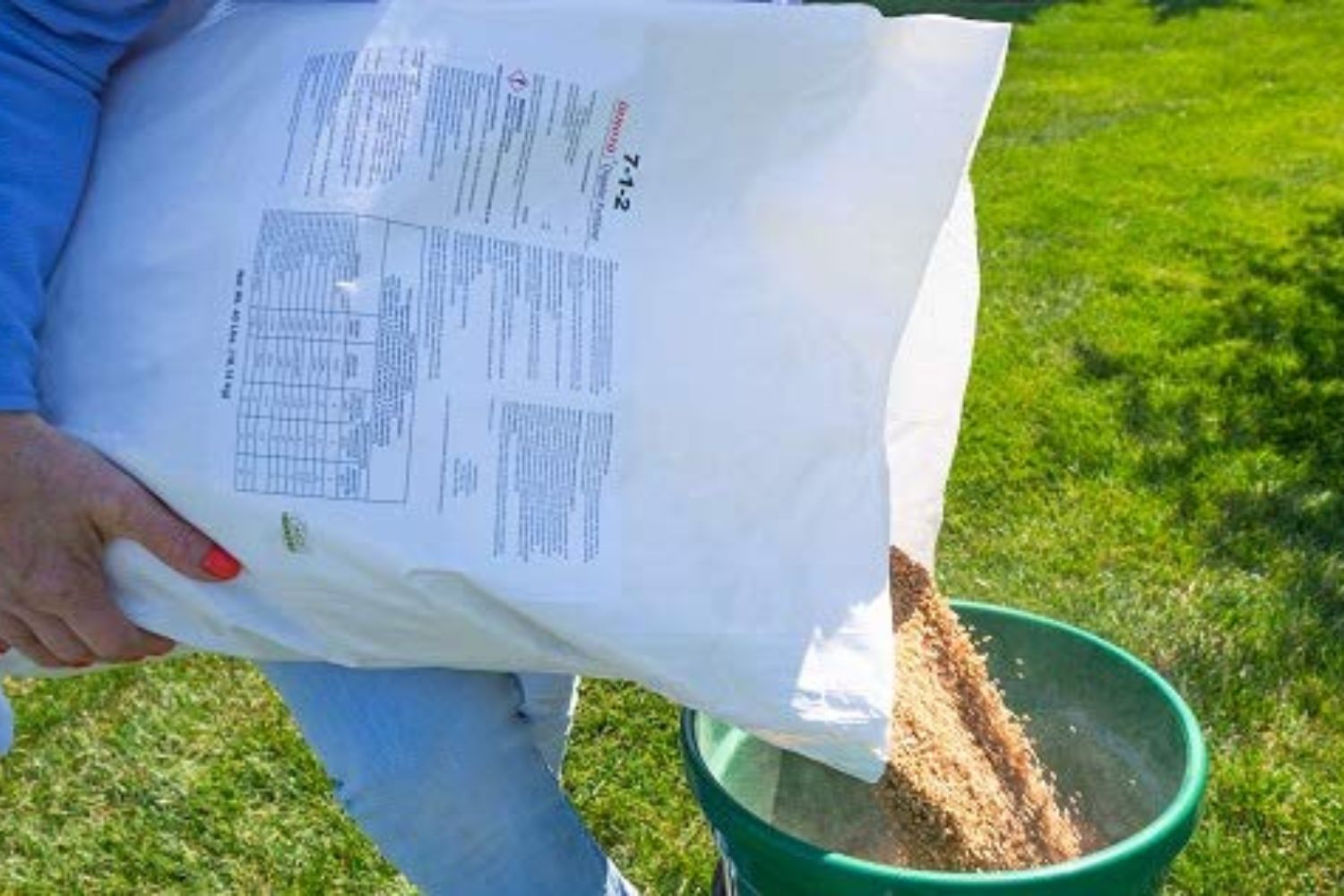
Before You Buy a Lawn Fertilizer for Spring
When choosing a fertilizer for grass, it’s important to consider its potential for harm. Lawn fertilizers can have far-reaching effects on the environment and human health, including the potential to harm wildlife and contaminate groundwater. Some fertilizers are safer than others.
Lawn fertilizers can be broadly broken down into two categories depending on their ingredients: organic and chemical. Organic or natural fertilizers are directly derived from plants or animals. They can contain ingredients like alfalfa, cottonseed meal, seaweed, manure, or bone meal. Inorganic or chemical fertilizers are synthetically produced, often from mineral deposits.
The ingredients in organic fertilizer are often in a natural and minimally processed form, which means they take longer for lawns to absorb, while chemical fertilizers are already in a usable form and absorb more quickly. Organic options are generally safer than chemical fertilizers due to their natural ingredients and the fact that they don’t produce chemical runoff (although some runoff from organic fertilizers can also still be harmful). For either type, it’s crucial to always follow the directions on the usage label to reduce health and environmental risks.
It may be best to do a soil test to determine which nutrients the lawn is lacking before choosing a lawn fertilizer. (It’s usually necessary to test the soil about every 1 to 3 years, or more often, as needed.) The results allow folks to choose grass food with the nutrients their lawn needs, which can help reduce potential harm to the lawn and the environment.
How We Chose the Best Lawn Fertilizers for Spring
Natural lawn fertilizers come with several benefits, both for the soil and the environment. Their lack of synthetic ingredients means they don’t produce chemical runoff. Depending on the ingredients list, they can pose less of a risk to people and pets compared to chemical options. Plus, they benefit the soil in the long run, often lasting longer than chemical options and improving soil structure, water movement, and the health of soil microorganisms over time. For these reasons, we mainly stuck with organic lawn fertilizers for the top picks in this guide.
The ideal fertilizer formula will vary from lawn to lawn, so we prioritized other factors. We chose the best lawn-care products that are highly rated for their effectiveness and ease of use. Since fertilizing has to occur semi frequently, we also considered price, choosing a range of budget-friendly options.
Our Top Picks
A healthy lawn is key to curb appeal, but grass demands proper care to look lush and green. Wondering what fertilizer to use in spring? We’ve rounded up some of the best lawn fertilizers for yard maintenance.
Best Overall
Espoma Organic Lawn Food Spring Lawn Booster
Pros
- Nitrogen-rich formula helps nourish soil for healthier, greener grass
- Fortified with calcium to improve lawn strength and protect from disease
- Suitable for all grass types, including newly seeded and sodded areas
Cons
- Not suitable for lawns with phosphorus or potassium deficiencies
- Some reviewers note this fertilizer has an unpleasant smell
Product Specs
- NPK ratio: 8-0-0
- Quantity: 30 pounds
- Coverage: Up to 5,000 square feet
As a reputable brand in organic lawn products, Espoma Organic Lawn Booster fertilizer was a natural choice as our top pick. This organic fertilizer is derived from feather meal, poultry manure, and gypsum to create an all-natural and nonburning slow-release fertilizer. An added ingredient, calcium, helps to strengthen lawns and protect from disease.
Nitrogen deficiency is the most common deficiency in most lawns, so to suit a broad range of lawns and boost springtime growth, this fertilizer has a nitrogen-rich formula. What’s more, the 8-0-0 nitrogen-phosphorus-potassium (NPK) ratio means it doesn’t include phosphorus or potassium, which will be welcome news to folks whose lawns don’t have these deficiencies. (For a detailed discussion of NPK ratio, see the section NPK Ratio below our product reviews.) This fertilizer comes in granule form, and the 30-pound bag will provide up to 5,000 square feet of lawn coverage.
Get the Espoma Organic Lawn Booster lawn fertilizer for spring at Amazonor Ace Hardware.
Best Bang for the Buck
Urban Farm Fertilizer Liquid Lawn Fertilizer
Pros
- Formula has a high nitrogen content, as well as extra nutrients for grass health
- The ultra-concentrated liquid formula makes this a very affordable choice
- Up to 60,000 square feet of yard coverage from a single 1-gallon bottle
Cons
- Requires more frequent application than many granule fertilizers
Product Specs
- NPK ratio: 13-1-2
- Quantity: 1 gallon
- Coverage: Up to 60,000 square feet
Affordable and super concentrated, this 1-gallon bottle of Urban Farm Fertilizer Liquid Lawn fertilizer makes enough product to treat a 5,000-square-foot lawn at least eight times (treating up to around 60,000 square feet of lawn in total).
This high-nitrogen formula provides a concentrated boost of nitrogen for grass growth and greening. It has an NPK ratio of 13-1-2, plus it’s fortified with a range of other nutrients, including magnesium, sulfur, and iron. These nutrients are derived from sources like bat guano, worm castings, and sea kelp. This fertilizer is a liquid option, so frequent treatments are recommended—Urban Farm specifies two or three times a month for most lawns.
Get the Urban Farm Fertilizer lawn fertilizer for spring at Amazon.
Best Liquid
GS Plant Foods Organic Liquid Fish
Pros
- Fish-derived formula provides a range of natural macro- and micro- nutrients
- Safe for use on all plants, from lawns to shrubs to vegetable gardens
- Recommended to reapply every 4 weeks, which is less frequent than many other liquid fertilizers
Cons
- Fishy smell can be off-putting, though it fades over time
Product Specs
- NPK ratio: 2-3-1
- Quantity: 1 gallon
- Coverage: Up to 10,890 square feet
GS Plant Foods Organic Liquid Fish lives up to its name; this liquid fertilizer is literally derived from fish. It’s an all-natural option that’s packed with nutrients, including trace minerals, amino acids, calcium, and enzymes. The slow-release formula provides nourishment to soil for up to 15 weeks, though users should apply it every 4 weeks for optimal results.
With a 2-3-1 NPK ratio, this fertilizer is an excellent choice for lawn maintenance, but it can also be used for other plants as well, from indoor houseplants to a vegetable garden. Its natural formula improves soil quality and promotes root growth for healthier lawns.
Get the GS Plant Foods lawn fertilizer for spring at Amazon.
Best Weed and Feed
Espoma Organic Weed Preventer
Pros
- Does not include chemical herbicides or fertilizers; made from 100 percent corn gluten meal
- Keeps new weeds from growing while also fertilizing the lawn
- Lawn is safe for people and pets to use immediately after application
Cons
- Won’t kill existing weeds—only prevents new weeds from sprouting
- Only suitable for use on established lawns
Product Specs
- NPK ratio: 9-0-0
- Quantity: 25 pounds
- Coverage: Up to 2,500 square feet
Weed-and-feed products pack a two-in-one punch, choking out weeds while also fertilizing lawns. Espoma Organic Weed Preventer is the best weed and feed for spring, with a natural ingredients list that doesn’t include any potentially harmful herbicides or fertilizers. This product is made from 100 percent corn gluten meal, a natural product that helps prevent new weeds from growing. It’s effective on established lawns against dandelions, crabgrass, and other common weeds.
In terms of fertilizing, this fertilizer has an NPK ratio of 9-0-0. It’s a slow-release option that provides nonburning and long-lasting greening. The 25-pound bag of granules feeds up to 2,500 square feet of lawn as fertilizer, or up to 1,250 square feet of coverage for weed prevention. Its ultrasafe ingredients list means that children and pets can play on the lawn immediately after it’s set down.
Get the Espoma Organic Weed Preventer lawn fertilizer for spring at Ace Hardware, Overstock, or Amazon.
Best Plant-Based
The Andersons 7-1-2 Innova Organic Fertilizer
Pros
- 100 percent plant-derived and does not contain animal parts, waste products, manure, or biosolids
- Low-dust and homogenous-size granules make application even and easy
- Does not have an unpleasant smell like some fertilizers with animal products
- OMRI-listed and is suitable for organic lawns and gardens
Cons
- A few reviewers reported bugs in the product
Product Specs
- NPK ratio: 7-1-2
- Quantity: 40 pounds
- Coverage: Up to11,000 square feet
There are a few reasons why a gardener might choose a plant-based fertilizer. First, it’s suitable for those who avoid using animal products, and second, there are no biosolids, manure, or animal parts involved (or the smells that come along with these common fertilizer ingredients). The Andersons 7-1-2 Innova organic fertilizer is derived from soybean meal and contains no animal ingredients or composted waste products.
This granular fertilizer is organic, slow-release, and OMRI listed, which means it meets the Organic Materials Review Institute’s requirements and is suitable for organic gardening. It has an NPK ratio of 7-1-2, so it’s a balanced fertilizer option. Suitable for all grass types and climates, it’s safe for homes with children and pets as well as for use around environmentally sensitive waterways.
Get The Andersons lawn fertilizer for spring at Amazon or The Home Depot.
Best without Phosphorus
Safer Brand 9335SR Lawn Restore Lawn Fertilizer
Pros
- Does not have phosphorus; ideal for lawns that have enough of this nutrient
- Formula helps thicken lawns by strengthening grass-root systems
- Long lasting; allows you to go up to 8 weeks between applications
Cons
- Some users found this product dusty, which can make it unpleasant to spread
Product Specs
- NPK ratio: 9-0-2
- Quantity: 20 pounds
- Coverage: 5,000 square feet
With a 9-0-2 NPK ratio, Safer Brand Lawn Restore fertilizer doesn’t contain phosphorus, making it a good choice for lawns that already have enough of this nutrient. It’s also well suited to centipede and St. Augustine lawns, which often don’t need a phosphorus fertilizer. Though specially formulated for revitalizing and thickening lawns, it’s an excellent option for eco-conscious shoppers who don’t want to contribute to unnecessary phosphorus runoff.
This slow-release fertilizer is nonburning and works to strengthen root systems for healthier grass. One 20-pound bag of fertilizer granules provides up to 5,000 square feet of lawn coverage. When used as directed, the lawn is safe for people and pets to use immediately after application and only needs to be reapplied every 8 weeks or so.
Get the Safer Brand lawn fertilizer for spring at Amazon, Ace Hardware, Tractor Supply Co., or Safer Brand.
Best for Greening
Milorganite 0636 Organic Nitrogen Fertilizer
Pros
- Includes iron to help aid in grass greening and soil health
- Iron ingredients are nonstaining and won’t mark concrete pathways and driveways
- Slow-release formula feeds lawns for up to 10 weeks
Cons
- NPK ratio of product can fluctuate due to manufacturing process
Product Specs
- NPK ratio: 6-4-0
- Quantity: 36 pounds
- Coverage: 2,500 square feet
Due to the addition of iron, Milorganite 0636 organic nitrogen fertilizer is the best fertilizer for yellow grass on our list because that yellow color is often due to an iron deficiency. Iron can help grass grow vibrant green and healthy, and Milorganite uses an organically complex iron that feeds consistently during the fertilizing period. Bonus: The iron won’t stain concrete like some products can.
This fertilizer formula is nonburning and slow-release, feeding lawns for up to 10 weeks. It has an NPK ratio of 6-4-0, with an emphasis on nitrogen for grass growth. The bag includes 36 pounds of granules to cover 2,500 square feet.
Get the Milorganite lawn fertilizer for spring at Amazon, Ace Hardware, or Lowe’s.
Best for Lawn and Garden
AgroThrive Organic General Purpose Liquid Fertilizer
Pros
- General-purpose fertilizer can be used on a wide range of plants, including lawns
- OMRI listed, which means it is suitable for organic gardens
- Includes fast-release ingredients to fertilize plants quickly upon application
Cons
- Some reviewers note this fertilizer has a strong and unpleasant smell
Product Specs
- NPK ratio: 3-3-2
- Quantity: 2.5 gallons
- Coverage: Not specified
There are a few fertilizers in this lineup that can work for both lawn and garden, but AgroThrive liquid fertilizer is our top pick for this purpose. The versatile general-purpose fertilizer is formulated for “everything that grows,” according to the manufacturer. Safe to use in the backyard and the veggie patch, it’s OMRI listed, which means it’s a good choice for organic gardening. It doesn’t include any manure, but is instead derived from corn steep liquor and fermented fish byproducts.
For faster results, this fertilizer has both fast-release and slow-release ingredients. It comes in a liquid form with a 3-3-2 NPK ratio. A few bottle sizes are available; the 2.5-gallon concentrate container makes up to 160 gallons of fertilizer, though coverage area is not specified.
Get the AgroThrive lawn fertilizer for spring at Amazon, Ace Hardware, The Home Depot (5 gallons), or AgroThrive.
Also Consider
Scotts Natural Lawn Food
Pros
- Low-maintenance option—recommended to apply just 4 times a year
- OMRI listed, which means it’s suitable for organic lawns
- Provides a high concentration of nitrogen with a balanced ratio of phosphorus and potassium
Cons
- Some reviewers report their dogs were attracted to the fertilizer smell
Product Specs
- NPK ratio: 11-2-2
- Quantity: 29.1 pounds
- Coverage: 4,000 square feet
Scotts is a household name when it comes to lawn care, so folks who want to stick with a brand they already know might wish to choose Scotts Natural Lawn Food. This affordable granular fertilizer is as effective as many of Scotts’ products, but with a natural formula instead of chemical. Because of its natural ingredients list, the lawn is safe to walk on immediately after application of this lawn food, and it just needs to be applied four times a year. This product is also OMRI listed (certification that assures it is suitable for organic production), so it’s a good choice for organic gardeners.
Suitable for year-round application, this fertilizer has a high nitrogen concentration that is especially well suited for spring since nitrogen helps boost grass growth. This product has an NPK of 11-2-2. One bag includes 29.1 pounds of fertilizer to cover up to 4,000 square feet.
Get the Scotts lawn fertilizer for spring at Amazon, Ace Hardware, The Home Depot, or Scotts.
Jump to Our Top Picks
Our Verdict
From one of the top brands in natural gardening products, our top pick is the Espoma Organic Lawn Booster lawn fertilizer for spring since it’s reliable, effective, and reasonably priced. It only contains nitrogen, however, so products like the Urban Farm lawn fertilizer or GS Plant Foods lawn fertilizer are other excellent options for lawns that need a more balanced fertilizer.
There are popular chemical fertilizers listed in some of our other fertilizer articles, such as Simple Lawn Solutions 16-4-8 and Scotts Liquid Turf Builder Lawn Food in our Best Liquid Lawn Fertilizer guide. However, as we choose more sustainable products, these are no longer recommended in our top picks due to their synthetic ingredients list. Instead, we’ve opted for all-natural fertilizers, which still come with some usage risks but are generally safer than most chemical options.
What to Consider When Choosing a Lawn Fertilizer for Spring
A walk down the lawn fertilizer aisle can quickly become overwhelming with the array of colorful bags and bottles promising a lusher lawn. Not every fertilizer is suitable for every lawn, and some may actually do more harm than good. To choose the best lawn fertilizer, there are a few main factors to consider, which include the soil composition, grass type, NPK ratio, formula type, and safety considerations.
Soil Composition and Growing Region
There is no one-size-fits-all fertilizer for every lawn, even for lawns within similar regions. Soil type, environmental conditions, and past care can affect the soil composition, which in turn affects lawn health. At least every few years, conduct a soil test to see which nutrients the soil is lacking. Soil tests will determine the amount of three key nutrients—nitrogen, phosphorus, and potassium—present in the soil, which makes it possible to choose the best lawn fertilizer accordingly.
The growing region will let folks figure out what type of grass makes up a lawn (if they don’t already know). In cold regions, cool-season grass varieties are common, while in hotter regions, warm-season grasses are more common. Each variety has different fertilization needs and ideal lawn fertilizer schedule, so follow recommendations according to the grass variety or specific grass types.
Regardless of the grass type, remember that any lawn should only be fertilized when it’s actively growing. Fertilizing a dormant lawn can have a negative effect—more is not always better when it comes to fertilizing lawns, and timing is just as important as the fertilizer ingredients and usage frequency.
NPK Ratio
Wondering what the lawn fertilizer numbers mean? All lawn fertilizers display an NPK ratio, which describes how much nitrogen (N), phosphorus (P), and potassium (K) the fertilizer contains. The NPK is written as three numbers, always in the NPK order and separated by dashes (N-P-K). Each number represents the percentage of each nutrient the bag contains. For example, a 20-5-5 bag of fertilizer will contain 20 percent nitrogen, 5 percent phosphorus, and 5 percent potassium.
These three nutrients are key to lawn health, but not every lawn needs the same amount. A wide range of different NPK ratios are available to suit the huge variety of lawn needs. Lawn fertilizers for spring can have a higher nitrogen concentration to boost lawn growth. For a new lawn, consider a fertilizer with a higher phosphorus content to nourish the root system. However, it’s ultimately best to choose a fertilizer according to the soil’s needs. Use the results of a soil test to determine the ideal NPK ratio for a lawn.
Granular vs. Liquid
Fertilizers come in granular or liquid form. Both are effective choices, but they each have their benefits and drawbacks.
Granular fertilizer comes in a dry-granule form and is applied by using a broadcast spreader. Many granular fertilizers are slow-release, so they may need fewer applications per year than liquid options (which means a lower-maintenance lawn). However, while granules are easy to apply and are beginner-friendly, users will want to take care to apply evenly. Granules can run a higher risk of burning the lawn if over- or unevenly applied.
Liquid fertilizer comes in a liquid or crystal form that is diluted in water and then applied with a sprayer. There are formulas that have low burn potential, plus liquids can be easier to apply evenly than granular options, so it’s easier to reduce the lawn burn risk. Liquids are generally faster acting, but that means they often require more frequent application and can be more affected by rainfall than granules.
Safety
Always follow all the usage directions with lawn fertilizer, which will recommend fertilizer concentration, tips to avoid runoff, and a time frame when the lawn is safe to use (which is especially important for homes with children and pets). Organic fertilizers can have a better safety profile than chemical options—read the usage label to check.
Though organic fertilizers contain natural ingredients, it doesn’t mean they can’t have harmful effects. For example, many organic fertilizers contain phosphorus, which is actually not a nutrient lacking in some lawns. Phosphorus runoff can contribute to algae blooms that harm water quality and aquatic life. The potential environmental impact is why it’s important to only use fertilizers as directed, and why it’s prudent to conduct soil tests and only use necessary fertilizers (for example, if a lawn doesn’t need phosphorus, find a fertilizer without it).
Tips for Using Lawn Fertilizers for Spring
The lawn fertilizers on this list are slow-release fertilizers (almost all the best organic lawn fertilizers are), which means they’ll take some time to show results. Unlike fast-release fertilizers, which can give immediate nutrition to the soil, slow-release fertilizers can take several weeks to take effect. However, this often means a more consistent result, less chance of overfertilizing or fertilizer burn, and longer wait times before applications. For lawns that need a quick pick-me-up, fast-release fertilizers can serve as an urgent treatment, though keep in mind that many fast-release fertilizers are synthetic and not organic.
Regardless of the fertilizer type, there are a few important tips to keep in mind before fertilizing a yard. A good lawn maintenance place should always start with a soil test (to be repeated every 1 to 3 years) to find out the soil composition and needed nutrients.
Once a fertilizer has been chosen, carefully read and follow the usage label directions. In general, avoid applying fertilizer before heavy or prolonged rainfall in the forecast. Light to moderate rainfall is all right (and even beneficial) since it can help the fertilizer seep into the soil.
Take care when applying to lawn edges and in sloped areas, where the fertilizer can run off into nearby waterways or sewers. If using granules, sweep up stray granules off of sidewalks, driveways, or patios to reduce runoff. Always allow for proper drying or absorption time before using or mowing the lawn.
- Slow-release fertilizers are an excellent choice for lawn maintenance
- Conduct a soil test before choosing a lawn fertilizer
- Always follow the usage label directions
- Do not apply fertilizer right before heavy or prolonged rainfall
- Take steps to reduce the chance of fertilizer runoff, like not over-applying near lawn edges and sweeping up stray fertilizer granules from sidewalks
FAQs
Lawn fertilizers can replace lost nutrients in soil and contribute to a healthier and more beautiful lawn. From the fertilizer ingredients to usage habits and timing, there’s a lot to consider when choosing the best fertilizer to thicken grass and improve grass health and color. Read on for the answers to some frequently asked questions about spring lawn fertilizing.
Q. Is it better to seed or fertilize in the spring?
It depends. The best time to seed or fertilize a lawn will depend on your grass type, so search seeding and fertilizing schedules based on your chosen grass varieties. Most grasses can benefit from fertilizing in the spring. On the other hand, when it comes to seeding new grass, autumn tends to be a better time to seed cool-season grasses, and spring for warm-season grasses.
Q. How do I know if my grass needs fertilizer?
A soil test is the best way to find out. Soil tests are available for a low cost from gardening centers or local county extension offices. They often test the soil texture, pH level, and nutrient level, including levels of nitrogen, phosphorus, and potassium. Many soil test results will provide fertilizer recommendations for your lawn, taking a lot of the guesswork out of the process.
Q. How much lawn fertilizer do I need?
Follow the usage directions to determine how much lawn fertilizer you will need. The amount will vary from lawn to lawn, depending on your lawn size, soil composition, and the fertilizer formula. Most fertilizer products will display how many square feet of lawn they can cover, providing shoppers a better idea of how much they’ll need to buy.
Q. Should I put nitrogen on my lawn in the spring?
The surefire way to know if your lawn needs nitrogen is by administering a soil test. A soil test should be done every few years, though once a year is optimal. This will give you a better idea of if your soil is lacking in nitrogen.
Jasmine Harding has been writing about home and garden products since 2020. She consulted reputable university extension program resources to find factual and up-to-date information on lawn fertilizers. With sustainability in mind, she chose products that are safer for people and the environment, while also making sure they’re effective for a lush and healthy lawn.
